Page 57 of 86
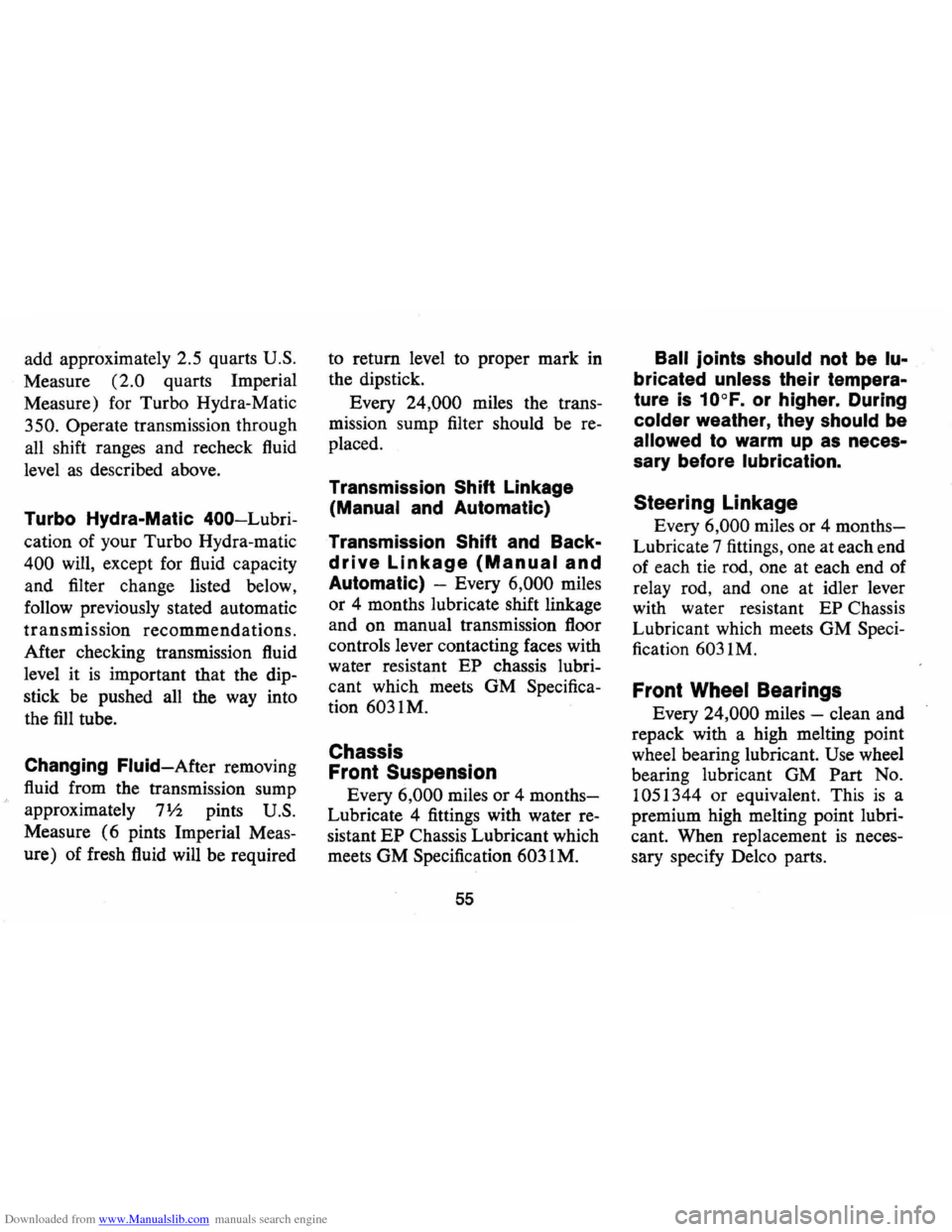
Downloaded from www.Manualslib.com manuals search engine add approximately 2.5 quarts U.S.
Measure (2.0 quarts Imperial
Measure) for Turbo Hydra-Matic
350. Operate transmission through
all shift ranges and recheck fluid
level
as described above.
Turbo Hydra-Matic 400-Lubri
cation of your Turbo Hydra-matic
400 will, except for fluid capacity
and filter change listed below,
follow previously stated automatic
transmission recommendations.
After checking transmission fluid
level it
is important that the dip
stick be pushed all the
way into
the
fill tube.
Changing Fluid-After removing
fluid from the transmission sump
approximately
7lh pints U.S.
Measure (6 pints Imperial Meas
ure) of fresh fluid will be required to
return level to proper mark in
the dipstick.
Every
24,000 miles the trans
mission sump filter should be re
placed.
Transmission Shift Linkage
(Manual and Automatic)
Transmission
Shift and Back·
drive Linkage (Manual and
Automatic) -Every 6,000 miles
or 4 months lubricate shift linkage
and on manual transmission floor
controls lever contacting faces with
water resistant EP chassis lubri
cant which meets GM Specifica
tion 6031M .
Chassis
Front Suspension
Every 6,000 miles or 4 months
Lubricate 4 fittings with water re
sistant
EP Chassis Lubricant which
meets GM Specification
6031 M.
55
Ball jOints should not be lu
bricated unless their tempera
ture
is 10°F. or higher. During
colder weather, they should be
allowed to warm up as neces
sary before
lubrication.
Steering Linkage
Every 6,000 miles or 4 months
Lubricate 7 fittings, one at each end
of each tie rod , one at each end of
relay rod, and one at idler lever
with water resistant EP Chassis
Lubricant which meets GM Speci
fication 6031M.
Front Wheel Bearings
Every 24,000 miles -clean and
repack with a high melting point
wheel bearing lubricant.
Use wheel
bearing lubricant GM Part No.
1051344 or equivalent. This
is a
premium high melting point lubri
cant. When replacement
is neces
sary specify Delco parts.
Page 58 of 86
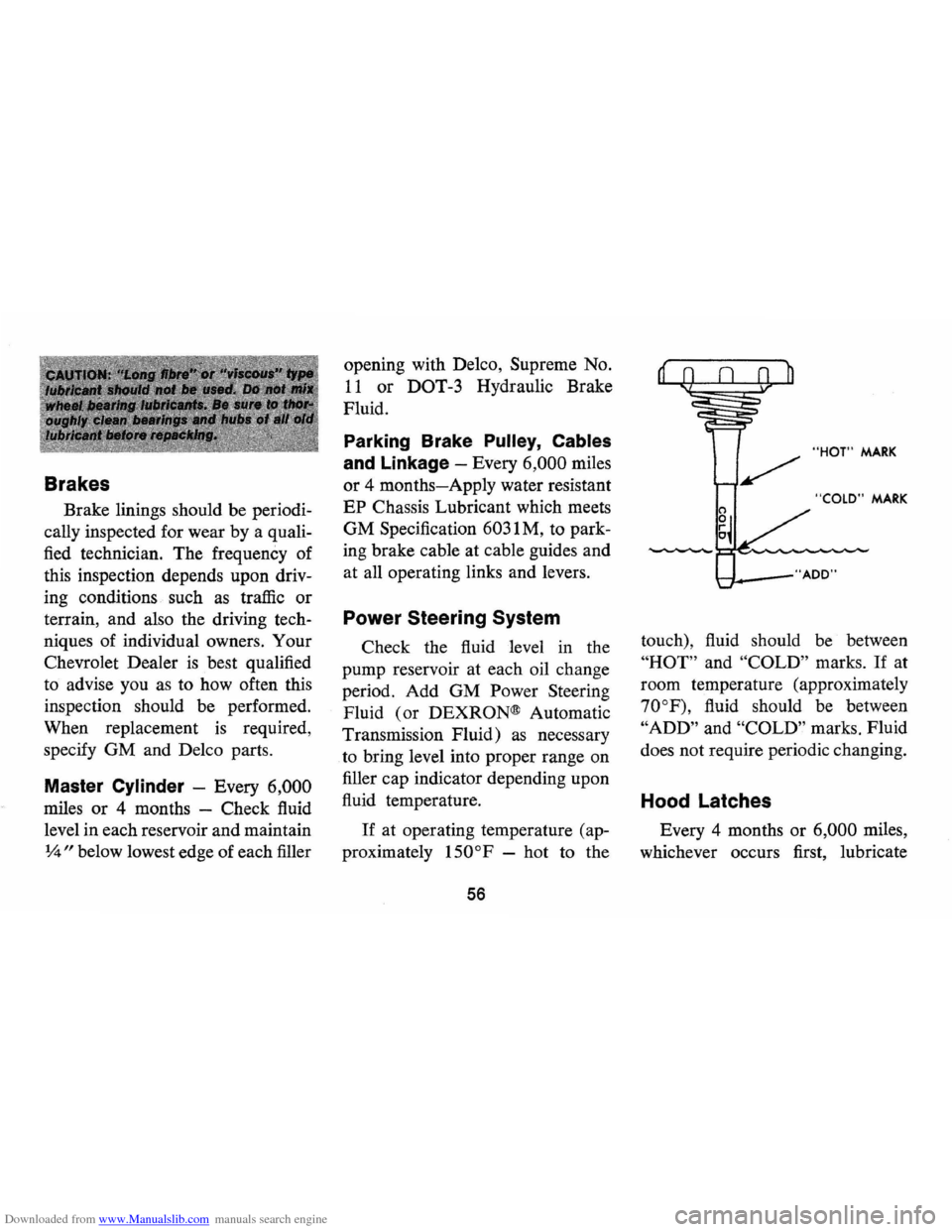
Downloaded from www.Manualslib.com manuals search engine Brakes
Brake linings should be periodi
cally inspected for wear by a quali
fied technician. The frequency of
this inspection depends upon driv
ing conditions such
as traffic or
terrain, and also the driving tech
niques of individual owners. Your
Chevrolet Dealer
is best qualified
to advise you
as to how often this
inspection should be performed.
When replacement
is required,
specify GM and Delco parts.
Master
Cylinder - Every 6,000
miles or 4 months -Check fluid
level in each reservoir and maintain
~ " below lowest edge of each filler opening
with Delco, Supreme No.
11 or DOT-3 Hydraulic Brake
Fluid.
Parking Brake
Pulley, Cables
and Linkage -Every 6,000 miles
or 4 months-Apply water resistant
EP Chassis Lubricant which meets
GM Specification 6031 M, to park
ing brake cable at cable guides and
at all operating links and levers.
Power
Steering System
Check the fluid level in the
pump reservoir at each oil change
period. Add GM Power Steering
Fluid (or
DEXRON® Automatic
Transmission Fluid)
as necessary
to bring level into proper range on
filler cap indicator depending upon
fluid temperature.
If at operating temperature (ap
proximately
150 °F - hot to the
56
"HOT" MARK
"COLD" MARK
touch), fluid should be between
"HOT" and "COLD" marks. If at
room temperature (approximately
70°F), fluid should be between
"ADD" and "COLD" marks. Fluid
does not require periodic changing.
Hood
Latches
Every 4 months or 6,000 miles,
whichever occurs first, lubricate
Page 59 of 86
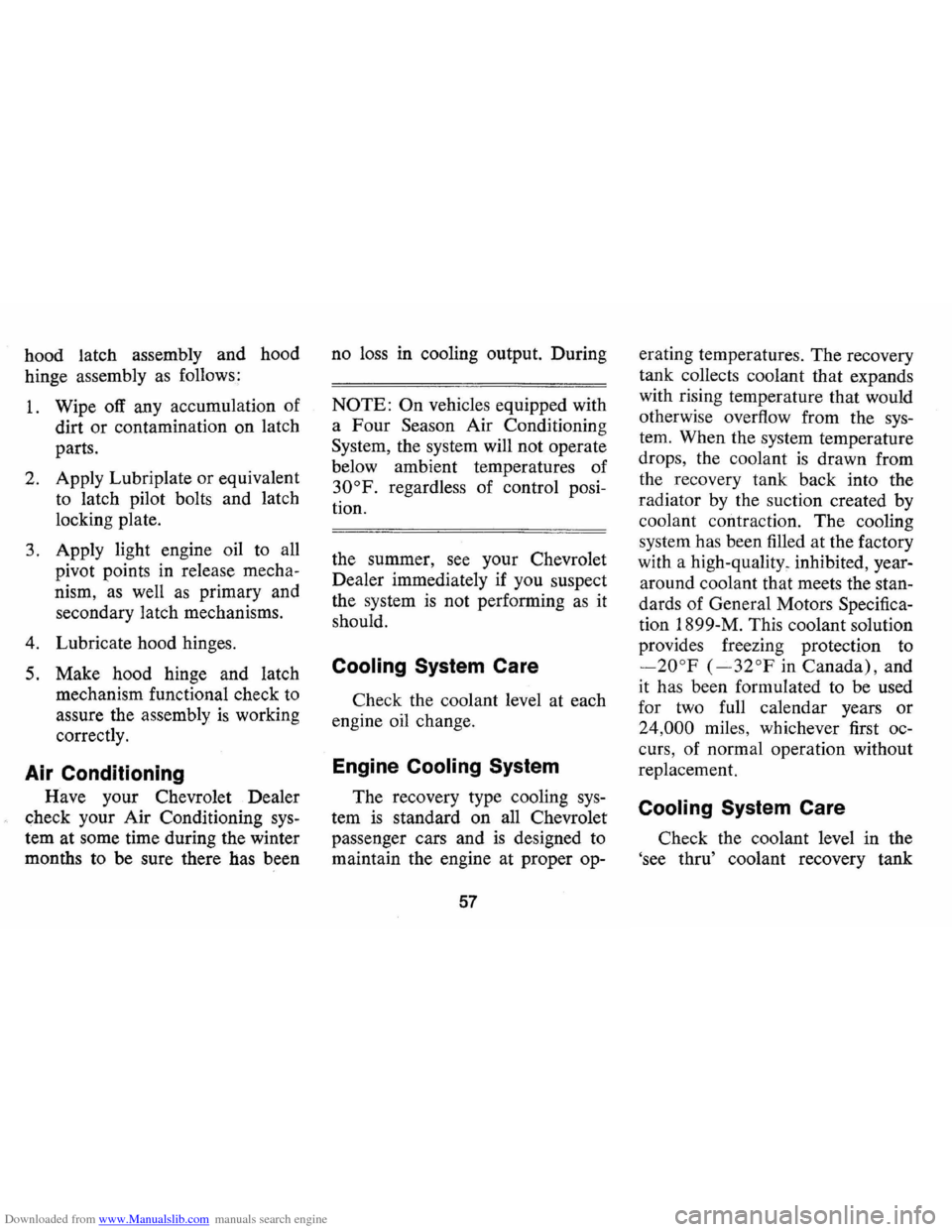
Downloaded from www.Manualslib.com manuals search engine hood latch assembly and hood
hinge assembly as follows:
1. Wipe off any accumulation of
dirt or contamination on latch
parts.
2. Apply Lubriplate or equivalent
to latch pilot bolts and latch
locking plate.
3. Apply light engine oil to all
pivot points in release mecha
nism, as well
as primary and
secondary latch mechanisms.
4. Lubricate hood hinges.
5. Make hood hinge and latch
mechanism functional check to
assure the assembly
is working
correctly.
Air Conditioning
Have your Chevrolet Dealer
check your Air Conditioning
sys
tem at some time during the winter
months to be sure there has been no
loss in cooling output. During
NOTE: On vehicles equipped with
a
Pour Season Air Conditioning
System, the system will not operate
below ambient temperatures of
300P. regardless of control posi
tion.
the summer,
see your Chevrolet
Dealer immediately if you suspect
the system
is not performing as it
should .
Cooling System Care
Check the coolant level at each
engine oil change.
Engine Cooling System
The recovery type cooling sys
tem is standard on all Chevrolet
passenger cars and
is designed to
maintain the engine at proper op-
57
erating temperatures. The recovery
tank collects coolant that expands
with rising temperature that would
otherwi se overflow from the sys
tem. When the system temperature
drops, the coolant
is drawn from
the recovery tank back into the
radiator by the suction created by
coolant contraction. The cooling
system has been filled at the factory
with a high-quality , inhibited, year
around coolant that meets the stan
dards of General Motors Specifica
tion 1899-M. This coolant solution
provides freezing protection to
-20oP (-32° P in Canada), and
it has been formulated to be used
for two full calendar years or
24,000 miles, whichever first oc
curs, of normal operation without
replacement.
Cooling System Care
Check the coolant level in the
'see thru' coolant recovery tank
Page 60 of 86

Downloaded from www.Manualslib.com manuals search engine and in the radiator at least as fre
quently
as engine oil changes.
NOTE: Do not remove radiator
cap when coolant
is hot and under
pressure.
Level should be at the
"FULL
COLD"
mark on the recovery tank
and at the bottom of the radiator
filler neck when the system
is cold.
During normal warm weather op
eration the coolant should be at
the
"FULL HOT" mark on the re
covery tank.
If the recovery tank is
empty or coolant is below the
"FULL COLD" mark the radiator
level should be checked and cool
ant added to the radiator and re
covery tank
as needed. Use a 50/50
mixture of high-quality ethylene gly
col antifreeze and water for coolant
additions.
If regular additions are
required see your dealer for a cool
ing system check.
NOTE: If recommended quaIily
antifreeze is used, supplemental in
hibitors or additives claiming to
provide increased capability are
not necessary. They may be detri
mental
to the efficient operation of
the system, and represent an un
necessary operating expense.
Every year, the cooling system
should be serviced
as follows:
1 . Wash radiator cap and filler
neck with clean water.
2. Check coolant for proper
level and freeze protection.
3. Pressure test system and radi
ator cap for proper pressure
holding capacity (15 psi).
If
replacement of cap is re
quired, use the special AC
cap designed for coolant re
covery systems, specified for
your car model.
4. Tighten hose clamps and in
spect all hoses. Replace hoses
58
whenever swollen, checked or
otherwise deteriorated.
5. Clean frontal area of radiator
core and air conditioning
condenser.
Every two years or
24,000 miles,
whichever first occurs, the cooling
system should be flushed and re
filled using the following recom
mended procedure:
1. Run engine, with radiator cap
removed, until normal operat
ing temperature
is reached
and upper radiator hose
is hot
(indicates thermostat
is open.)
2. Stop engine and open radiator
drain valve to drain coolant.
(To speed this operation, the
drain plugs in the block can
also be removed.)
Page 61 of 86
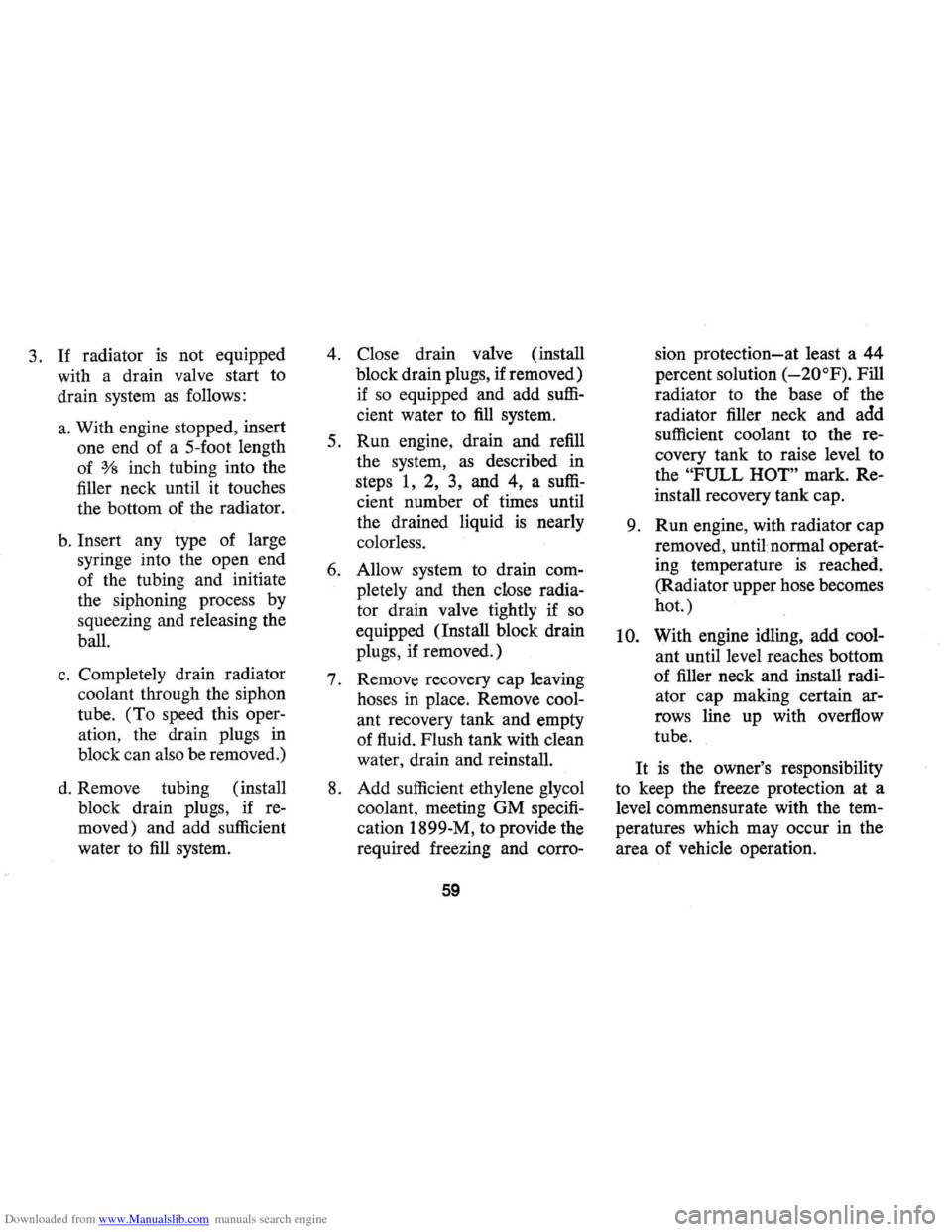
Downloaded from www.Manualslib.com manuals search engine 3. If radiator is not equipped
with a drain valve start to
drain system
as follows:
a. With engine stopped , insert
one end of a 5-foot length
of
% inch tubing into the
filler neck until it touches
the bottom of the radiator.
b. Insert any type of large
syringe into the open end
of the tubing and initiate
the siphoning process by
squeezing and releasing the
ball.
c. Completely drain radiator
coolant through the siphon
tube. (To speed this
oper
ation, the drain plugs in
block can also be removed.)
d. Remove tubing (install
block drain plugs,
if re
moved) and add sufficient
water to
fill system.
4. Close drain valve (install
block drain plugs,
if removed)
if so equipped and add
suffi
cient water to fill system.
5 . Run engine, drain and refill
the system,
as described in
steps
1, 2, 3, and 4, a suffi
cient number of times until
the drained liquid
is nearly
colorless.
6. Allow system to drain com
pletely and then close radia
tor drain valve tightly if so
equipped (Install block drain
plugs,
if removed.)
7. Remove recovery cap leaving
hoses in place. Remove
cool
ant recovery tank and empty
of fluid. Plush tank with clean
water, drain and reinstall.
8. Add sufficient ethylene glycol
coolant, meeting GM
specifi
cation 1899-M, to provide the
required freezing and corro-
59
sion protection-at least a 44
percent solution
(_200P). Pill
radiator to the base of the
radiator filler neck and add
sufficient coolant to the
re
covery tank to raise level to
the
"PULL HOT" mark. Re
install recovery tank cap.
9. Run engine, with radiator cap
removed, until normal
operat
ing temperature is reached.
(Radiator upper hose becomes
hot.)
10. With engine idling, add cool
ant until level reaches bottom
of filler neck and install
radi
ator cap making certain ar
rows line up with overflow
tube.
It is the owner's responsibility
to keep the freeze protection at a
level commensurate with the
tem
peratures which may occur in the
area of vehicle operation.
Page 62 of 86

Downloaded from www.Manualslib.com manuals search engine • Maintain cooling system freeze
protection at
.;...200 F or below
to ensure protection against
corrosion and loss of coolant
from boiling , even though freez
ing temperatures are not
ex
pected.
• Add ethylene glycol base cool
ant that meets GM Specification
1899-M when coolant additions
are required because of coolant
loss or to provide additional
protection against freezing at
temperatures lower than
_200 F
(_320 F in Canada).
NOTE: Alcohol or methanol base
coolants or plain water are not
recommended for your Monte
Carlo at any time.
Radiator Pressure Cap
The radiator cap, a 15 lb. pres
sure type, must be installed tightly,
otherwise coolant may be lost and
damage to engine may result from
overheating. Radiator pressure caps
should be checked periodically for
proper operation.
If replacement is
required specify AC.
Thermostat
The cooling system is protected
and controlled by a thermostat in
stalled in the engine coolant outlet
to maintain a satisfactory operating
temperature of the engine. This
thermostat
is designed for continu
ous use through both winter and
summer and need not be changed
seasonally . When replacement
is
necessary, Delco parts are recom
mended.
60
Tires
The factory installed tires on
your car
as shown on the following
Tire Usage chart are designed to
provide the best all around per
formance for normal vehicle op
eration. When inflated
as recom
mended on the tire pressure plac
ard, located on the left door of
your vehicle, they have the load
carrying capacity to operate satis
factorily at all normal highway
speeds.
Tire Care
Tires should be checked regu
larly for proper inflation pressure,
wear, and damage. The following
information will assist you in prop
erly caring for your tires:
Page 63 of 86
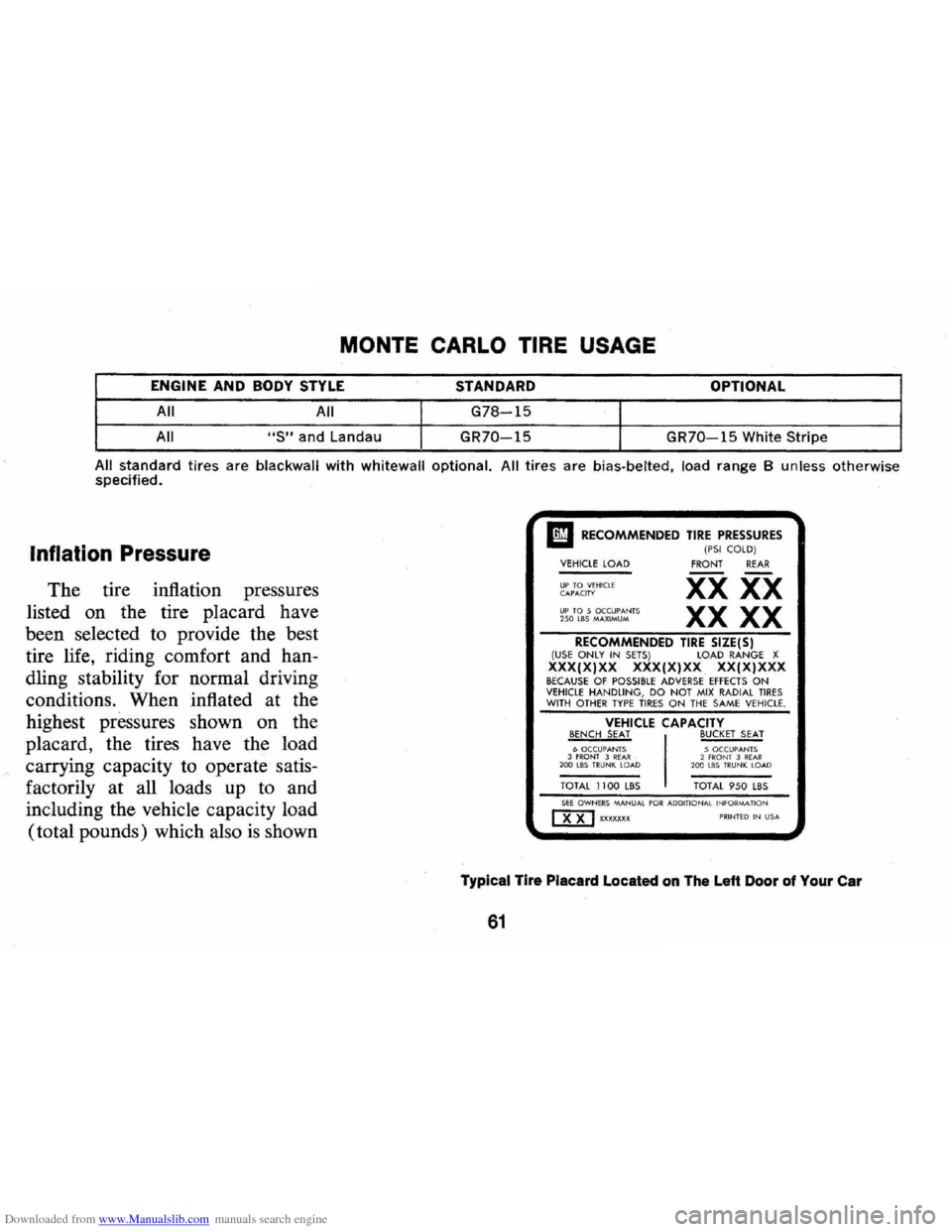
Downloaded from www.Manualslib.com manuals search engine MONTE CARLO TIRE USAGE
ENGINE AND BODY STYLE STANDARD OPTIONAL
All All
G78-15
All "S" and Landau GR70-15
GR70-15 White Stripe
All standard tires are blackwall with whitewall optional. All tires are bias·belted, load range B unless otherwise specified.
Inflation Pressure
The tire inflation pressures
listed on the tire placard have
been selected to provide the best
tire life, riding comfort and han
dling stability for normal driving
conditions. When inflated at the
highest pressures shown on the
placard, the tires have the load
carrying capacity to operate satis
factorily at all loads up to and
including the vehicle capacity load
(total pounds) which also
is shown
I!I RECOMMENDED TIRE PRESSURES (PSI COLD) VEHICLE LOAD
UP TO VEHICLE C APACIH UP TO 5 OCCU PANTS 250 185 MAX IMUM
FRONT REAR
xx XX
XX XX
RECOMMENDED TIRE SIZE(S) (USE ON LY IN SETS ) LOAD RANGE X XXX(X)XX XXX(X)XX XXIX)XXX BECAUSE OF POSSIBLE ADVERSE EFFECTS ON VEHICLE HANDLING, DO N O T MIX RADIAL TIRES WITH OTHER TYPE TIRES ON THE SA ME VEHICLE.
VEHICLE CAPACITY BENCH SEAT BUCKET SEAT 6 OCCUPANTS 3 fR ONT 3 REAR· 200 lBS TRUNK LOAD
TOTAL 1100 LBS
5 OCCUPAN TS 2 fR ONT 3 R EA R 200 U1S TRU NK LOA D
TOTAL 950 LBS SEE OWNERS MANUAL fOR ADD ITIONAL INfORMAflON mJ XXXXXXX PRINTED IN USA
Typical Tire Placard Located on The Left Door of Your Car
61
Page 64 of 86
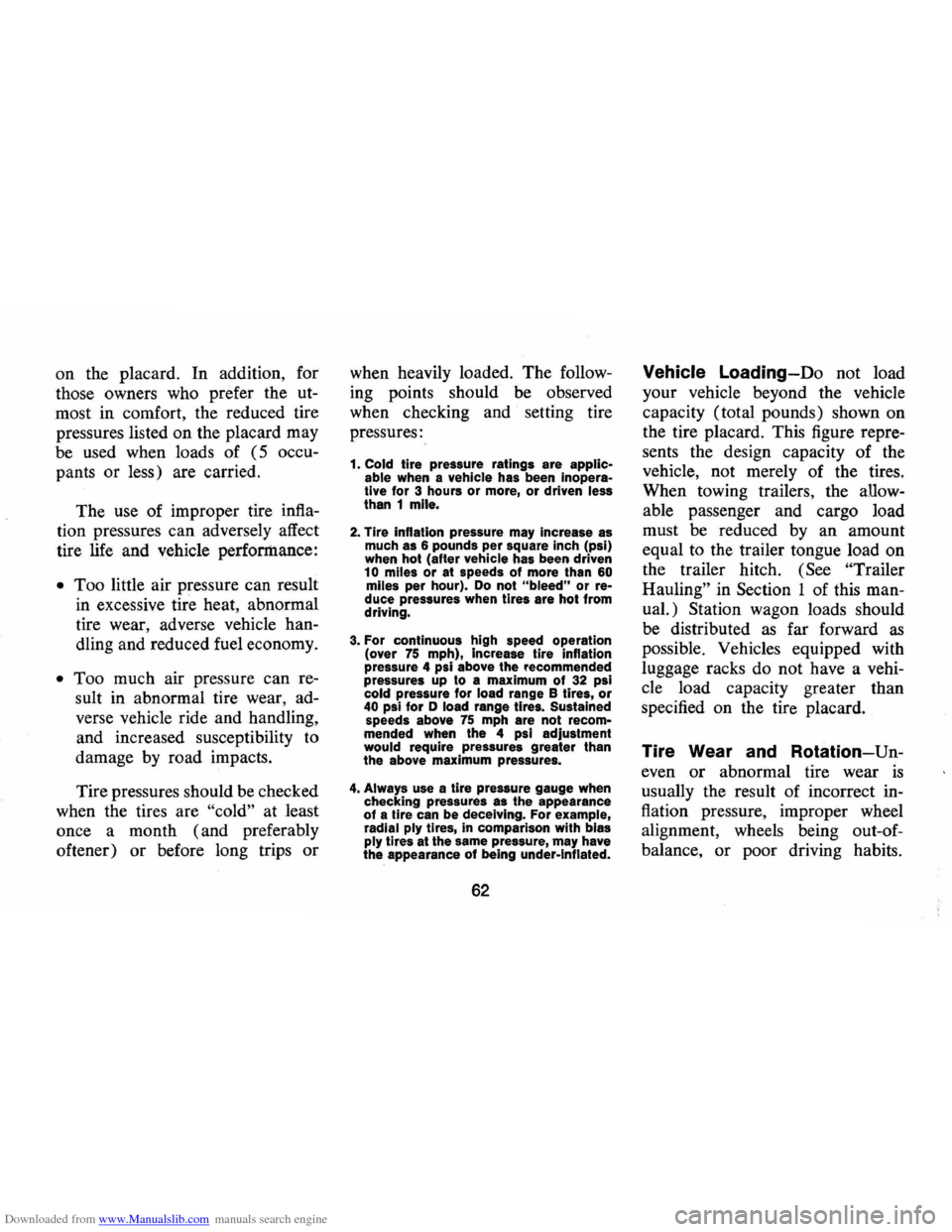
Downloaded from www.Manualslib.com manuals search engine on the placard. In addition, for
those owners who prefer the
ut
most in comfort, the reduced tire
pressures listed on the placard may
be used when loads of
(5 occu
pants or less) are carried.
The use of improper tire
infla
tion pressures can adversely affect
tire life and vehicle
perforrilance:
•
Too little air pressure can result
in excessive tire heat, abnormal
tire wear, adverse vehicle
han
dling and reduced fuel economy.
• Too much air pressure can re
sult in abnormal tire wear, ad
verse vehicle ride and handling,
and increased susceptibility to
damage
by road impacts.
Tire pressures should be checked
when the tires are
"cold" at least
once a month (and preferably
oftener)
or before long trips or
when heavily loaded. The follow
ing points should be observed
when checking and setting tire
pressures:
<
1. Cold tire pressure ratings are applic
able when a vehicle has been Inoperative for 3 hours or more, or driven less
than 1 mile.
2. Tire inflation pressure may increase as much as 6 pounds per square inch (psi)
when hot (after vehicle has been driven
10 miles or at speeds of more than 60 miles per hour). Do not "bleed" or reduce pressures when tires are hot from
driving.
3. For continuous high speed operation
(over 75 mph), increase tire inflation
pressure 4 psi above the fecommended
pressures up to a maximum
of 32 psi
cold pressure for load range B tires, or 40 psi for D load range tires. Sustained
speeds above 75 mph are not recom
mended when the 4 psi adjustment
would require pressures greater than
the above maximum pressures.
4. Always use a tire pressure gauge when
checking pressures as the appearance of a tire can be deceiving. For example,
radial ply tires, in comparison with bias
ply tires at the same pressure, may have
the appearance of being under-Inflated.
62
Vehicle Loading-Do not load
your vehicle beyond the vehicle
capacity (total pounds) shown on
the tire placard. This figure
repre
sents the design capacity of the
vehicle, not merely of the tires.
When towing trailers, the
allow
able passenger and cargo load
must be reduced by an amount
equal to the trailer tongue load on
the trailer hitch.
(See "Trailer
Hauling" in Section 1 of this man
ual.) Station wagon loads should
be distributed
as far forward as
possible. Vehicles equipped with
luggage racks do not have a
vehi
cle load capacity greater than
specified on the tire placard.
Tire Wear and Rotation-Un
even or abnormal tire wear is
usually the result of incorrect in
flation pressure, improper wheel
alignment, wheels being
out-of
balance, or poor driving habits.